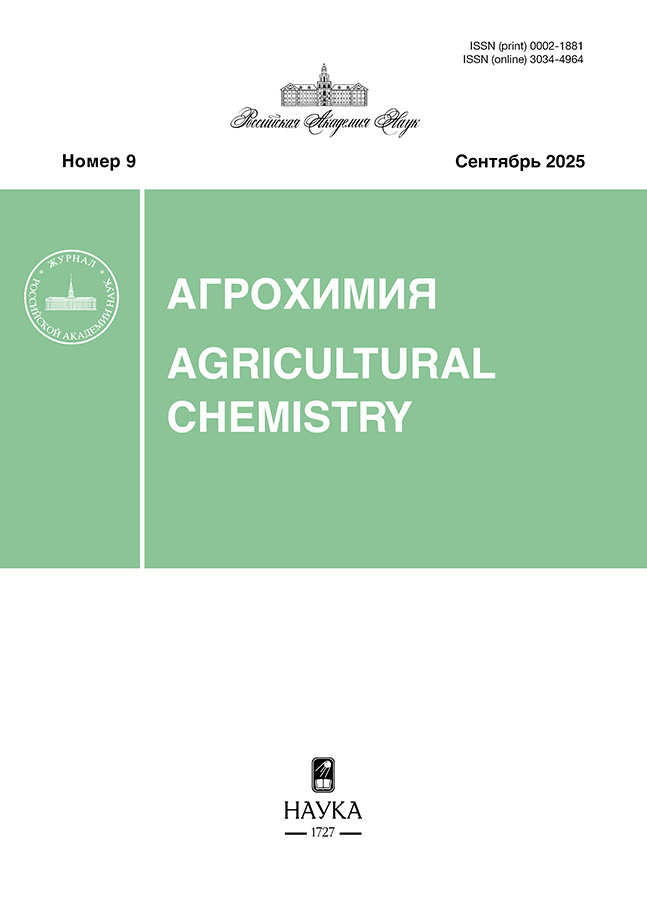Изменение плодородия аллювиальной луговой почвы при разных системах удобрения в овощном севообороте
- Авторы: Васючков И.Ю.1, Борисов В.А.1, Успенская О.Н.1
-
Учреждения:
- Всероссийский научно-исследовательский институт овощеводства – филиал Федерального научного центра овощеводства
- Выпуск: № 5 (2023)
- Страницы: 13-19
- Раздел: Экспериментальные статьи. Плодородие почв
- URL: https://modernonco.orscience.ru/0002-1881/article/view/647035
- DOI: https://doi.org/10.31857/S0002188123030122
- EDN: https://elibrary.ru/KOFONG
- ID: 647035
Цитировать
Полный текст
Аннотация
В лабораторно-полевом опыте, проведенном в климатических условиях Московской обл., установлено, что после 2-х ротаций (6 лет) насыщенного овощного севооборота (капуста белокочанная поздняя–морковь–свекла столовая) на аллювиальной луговой среднесуглинистой почве при ежегодном внесении биокомпоста в дозе 6 т/га (суммарно 18 т/га) произошла стабилизация содержания гумуса в почве, отмечена тенденция к накоплению фракции щелочногидролизуемого азота (+6%) и расходованию подвижных форм фосфора (–4%) и калия (–6%), а также разуплотнению почвы. Использование минеральных удобрений в одинарной и полуторной дозах выявило тенденцию к снижению содержания гумуса в почве (на 3–4%), гидролизуемого азота (на 7–8%) и накоплению подвижных фосфора (на 1–15%) и калия (на 3–22%). Внесение половинной дозы минеральных удобрений привело к ухудшению почвенного плодородия, снижению содержания гумуса (–5%), подвижного фосфора и калия (на 5 и 17%). Чуть более эффективным было внесение ежегодно биокомпоста в дозе 3 т/га. При совместном внесении биокомпоста (6 т/га) и одинарной дозы NPK отмечена стабилизация содержания гумуса в почве на начальном уровне, накопление гидролизуемого азота (на 9%), подвижного фосфора и калия (на 5–6%). За 2 ротации отмечено снижение содержания обменного кальция (на 1–10% от начального уровня) и магния (на 3–11%) и слабое подкисление почвы (снижение рНKCl на 1–2% от начального показателя). Установлено, что средняя продуктивность пашни без применения удобрений составляла 50 т/га, при внесении половинной дозы повышалась на 14, одинарной – на 28, полуторной на –42%, применение биокомпоста в дозах 3 и 6 т/га обеспечивало рост продуктивности на 8–16%. При совместном ежегодном внесении биокомпоста с одинарной дозой NPK средняя продуктивность севооборота повышалась на 26–35%.
Ключевые слова
Об авторах
И. Ю. Васючков
Всероссийский научно-исследовательский институт овощеводства –филиал Федерального научного центра овощеводства
Email: usp-olga@yandex.ru
Россия, 140153, Московская обл., Раменский р-н, д. Верея, стр. 500
В. А. Борисов
Всероссийский научно-исследовательский институт овощеводства –филиал Федерального научного центра овощеводства
Email: usp-olga@yandex.ru
Россия, 140153, Московская обл., Раменский р-н, д. Верея, стр. 500
О. Н. Успенская
Всероссийский научно-исследовательский институт овощеводства –филиал Федерального научного центра овощеводства
Автор, ответственный за переписку.
Email: usp-olga@yandex.ru
Россия, 140153, Московская обл., Раменский р-н, д. Верея, стр. 500
Список литературы
- Сычев В.Г., Ефремов Е.Н., Завалин А.А., Романенков В.А., Шафран С.А., Аристархов А.Н., Шильников И.А. Прогноз потребности и платежеспособного спроса сельского хозяйства Российской Федерации на минеральные удобрения до 2020 года. М.: ВНИИА, 2011. 52 с.
- Журбицкий З.И. Физиологические и агрохимические основы применения удобрений. М.: АН СССР, 1963. 293 с.
- Борисов В.А. Система удобрения овощных культур. М.: Росинформагротех, 2016. 392 с.
- Добровольский Г.В. Почвы речных пойм центра Русской равнины. М.: Изд-во МГУ, 1968. 295 с.
- Кораблева Л.И. Плодородие, агрохимические свойства и удобрение пойменных почв Нечерноземной зоны. М.: Наука, 1969. 278 с.
- Борисов В.А., Васючков И.Ю., Успенская О.Н. Калийный режим аллювиальной луговой почвы поймы р. Москвы при длительном применении удобрений в овощекормовом севообороте // Агрохимия. 2013. № 2. С. 11–14.
- Борисов В.А., Васючков И.Ю., Успенская О.Н. Азотный режим аллювиальной луговой почвы поймы р. Москвы а при длительном применении удобрений в овощекормовом севообороте // Агрохимия. 2014. № 9. С. 8–12.
- Борисов В.А., Васючков И.Ю., Успенская О.Н., Гренадеров Н.В. Фосфатный режим аллювиальной луговой почвы после 30-летнего применения минеральных удобрений в овощекормовом севообороте // Агрохимия. 2014. № 1. С. 23–26.
- Литвинов С.С. Методика полевого опыта в овощеводстве. М.: Россельхозакадемия, 2011. 649 с.
- Агрохимические методы исследования почв. М.: Наука, 1975. 625 с.
- Державин Л.М., Попова Р.Н., Дегтярова Н.И. Нормативы выноса элементов питания сельскохозяйственными культурами. М.: МСХА, 1991. 66 с.
- Круг Г. Овощеводство. Пер. с нем. В.И. Леунова. М.: Колос, 2000. 576 с.
Дополнительные файлы













